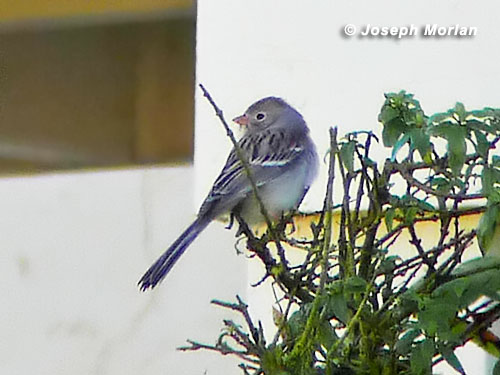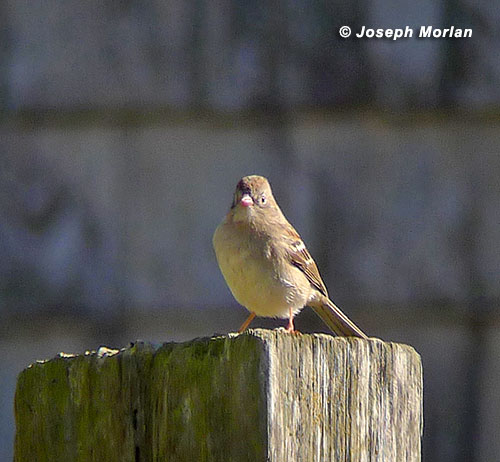Field Sparrow (Spizella pusilla)
Historic "A" Ranch, Point Reyes, Marin County, CA
4 November 2012
Joseph Morlan
Photos © 4 November 2012 by Joseph Morlan. All rights reserved (Higher resolution images).
 Dan Singer and I visited the Nunes Ranch this morning hoping to see the Field Sparrow
found yesterday by Keith Hansen's Marin Audubon field trip. This site is an old Dairy Ranch with Monterey Cypresses
planted as a windbreak [map]. Several birders were present when we arrived
and we learned from Logan Kahle and Michael Park that they had seen the bird earlier at the end of the row of cypresses.
Soon Dave DeSante located the bird foraging within a wire fence in front of one of the unoccupied ranch buildings.
Eventually the bird entered a small area near the main occupied building where it foraged on the ground. Here the
sparrow was visible only from the road, being otherwise hidden from view by a fence. As the bird foraged on the
ground, one of many free roaming House Cats almost caught the Field Sparrow. We witnessed the sparrow's near demise
twice during the time we had it under observation.
Dan Singer and I visited the Nunes Ranch this morning hoping to see the Field Sparrow
found yesterday by Keith Hansen's Marin Audubon field trip. This site is an old Dairy Ranch with Monterey Cypresses
planted as a windbreak [map]. Several birders were present when we arrived
and we learned from Logan Kahle and Michael Park that they had seen the bird earlier at the end of the row of cypresses.
Soon Dave DeSante located the bird foraging within a wire fence in front of one of the unoccupied ranch buildings.
Eventually the bird entered a small area near the main occupied building where it foraged on the ground. Here the
sparrow was visible only from the road, being otherwise hidden from view by a fence. As the bird foraged on the
ground, one of many free roaming House Cats almost caught the Field Sparrow. We witnessed the sparrow's near demise
twice during the time we had it under observation.
The bird spent most of its time close to the main building, which is private property. It also had the habit
of flying considerable distance and disappearing for periods of time before returning to the vicinity of the main
ranch house. Additional observers included Scott Terrill, Jon Winter, Frances Oliver, Liz West, Emily Strauss,
Jeff Miller, David Nelson and numerous others.
Description
The following description is based on memory and on photos:
A small sparrow with a very long tail. The bird was decidedly smaller than nearby House Sparrows. The bill
seemed to be short and stubby, and fairly bright pink in color on both mandibles.
The crown was mostly rusty or rufous color, but the median area on the top of the head was gray, separating
the reddish area into two broad lateral crown stripes which connected broadly on the forehead. The face was rather
plain gray, similar to the gray color of the chest. The dark eye had a crisp well-defined white eyering. The nape
was neutral gray and lacked streaking, although a faint rusty stripe extended down the middle of the nape from
the crown to the back which separated the nape into two sections.
area on the top of the head was gray, separating
the reddish area into two broad lateral crown stripes which connected broadly on the forehead. The face was rather
plain gray, similar to the gray color of the chest. The dark eye had a crisp well-defined white eyering. The nape
was neutral gray and lacked streaking, although a faint rusty stripe extended down the middle of the nape from
the crown to the back which separated the nape into two sections.
The throat was white, contrasting with the gray chest and was framed by two short lateral throat stripes
(whisker marks). The rest of the underparts were whitish although some of my photos show a faint cream coloration.
I believe this was an artifact of reflection from the lichen on the post. I did not notice it in life. The sides
and flanks were gray with a slight warm rufous tint that was hard to see in the field.
The upperparts were gray-brown with rather fairly broad black streaks. Some rusty color was most evident
on the scapulars (see photo above right). The wings showed two prominent white wing-bars formed by the white tips
to the greater and median coverts. The the wing coverts, secondaries and tertials were otherwise black with brown
fringes on the outer webs.
The very long tail was gray-brown above, but pale gray below with pale outer webs to some of the tail feathers.
The tips of the rectrices were acutely pointed and appeared to me to abraded (see photo left). The legs, feet and
toes were pink.
Discussion
Age and sex
Field Sparrows are difficult to age unless examined in the hand. However, the strongly pointed rectrices and
the contrasting primary coverts (visible in the photos) suggest this may be a young bird (hatching year HY). Females
average slightly smaller than males and are more dull in color. Although this bird is very dull suggesting it might
be a female, the sex of this bird is probably not determinable with confidence.
Species
The identification is relatively straightforward. The most likely species to cause confusion is Brewer's Sparrow
(Spizella breweri). Brewer's often shows a fairly clear eyering and may show a pinkish bill. However, the
crown of Brewer's is brown with dusky streaks throughout, unlike the largely rufous cap of the Field Sparrow. Brewer's
also has streaks on the nape, more of an outline to the brown ear coverts, and is overall a colder brown colored
bird compared to this bird.
Another confusion species is Worthen's Sparrow (S. wortheni) which has dark legs and feet, lacks wing-bars
and has the rufous lateral crown stripes separated through the forehead instead of connected. Worthen's is locally
distributed in Northeast Mexico and has not been recorded in North America since the type specimen was reportedly
collected in Silver City, New Mexico in the 19th century.
Subspecies
Two races are currently recognized. The nominate S. p. pusilla is found in the East. It has a more distinct
gray median and back streaking. It also usually shows a brownish ear patch which contrasts with the gray of the
face and breast, and has a relatively shorter tail. Our bird shows characters of the western Great Plains race
S. p. arenacea which has a plainer face, less contrasting median stripe and back streaking and a relatively
longer tail.
Outside Links
- 3 November
- 4 November
- 5 November
 Dan Singer and I visited the Nunes Ranch this morning hoping to see the Field Sparrow
found yesterday by Keith Hansen's Marin Audubon field trip. This site is an old Dairy Ranch with Monterey Cypresses
planted as a windbreak [map]. Several birders were present when we arrived
and we learned from Logan Kahle and Michael Park that they had seen the bird earlier at the end of the row of cypresses.
Soon Dave DeSante located the bird foraging within a wire fence in front of one of the unoccupied ranch buildings.
Eventually the bird entered a small area near the main occupied building where it foraged on the ground. Here the
sparrow was visible only from the road, being otherwise hidden from view by a fence. As the bird foraged on the
ground, one of many free roaming House Cats almost caught the Field Sparrow. We witnessed the sparrow's near demise
twice during the time we had it under observation.
Dan Singer and I visited the Nunes Ranch this morning hoping to see the Field Sparrow
found yesterday by Keith Hansen's Marin Audubon field trip. This site is an old Dairy Ranch with Monterey Cypresses
planted as a windbreak [map]. Several birders were present when we arrived
and we learned from Logan Kahle and Michael Park that they had seen the bird earlier at the end of the row of cypresses.
Soon Dave DeSante located the bird foraging within a wire fence in front of one of the unoccupied ranch buildings.
Eventually the bird entered a small area near the main occupied building where it foraged on the ground. Here the
sparrow was visible only from the road, being otherwise hidden from view by a fence. As the bird foraged on the
ground, one of many free roaming House Cats almost caught the Field Sparrow. We witnessed the sparrow's near demise
twice during the time we had it under observation. area on the top of the head was gray, separating
the reddish area into two broad lateral crown stripes which connected broadly on the forehead. The face was rather
plain gray, similar to the gray color of the chest. The dark eye had a crisp well-defined white eyering. The nape
was neutral gray and lacked streaking, although a faint rusty stripe extended down the middle of the nape from
the crown to the back which separated the nape into two sections.
area on the top of the head was gray, separating
the reddish area into two broad lateral crown stripes which connected broadly on the forehead. The face was rather
plain gray, similar to the gray color of the chest. The dark eye had a crisp well-defined white eyering. The nape
was neutral gray and lacked streaking, although a faint rusty stripe extended down the middle of the nape from
the crown to the back which separated the nape into two sections.